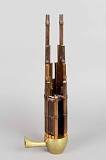Page 7 of 7
Concertina History & Background
- The English concertina is the only truly English invented instrument, as opposed to one that evolved
- The English concertina was ‘invented’ by Sir Charles Wheatstone, the famous physicist and member of the Royal Society, in 1829. The story goes the he heard the Chinese Sheng being played by
 sailors in the early 1800’s. Shengs had free reeds and he decided that there was room for this sound in the orchestra, so he developed the concertina, the treble having the same range as a violin. The first patents were issued in the mid 1830s.
sailors in the early 1800’s. Shengs had free reeds and he decided that there was room for this sound in the orchestra, so he developed the concertina, the treble having the same range as a violin. The first patents were issued in the mid 1830s. - The Anglo-German instrument was developed by Carl Freidrich Uhlig in 1834.
- To ‘productionise’ manufacture Wheatstone employed a clock making engineer called Louis Lachenal, who eventually developed his own version and set up in competition. Louis Lachenal was the most prolific manufacturer. Wheatstones were thought to be better instruments, but this distinction eventually blurred.
- There were other manufacturers in the mid 1800s and early 1900s but none were as significant as the first two, although some of their instruments were first class.
- At the moment, reproduction instruments are being made, mainly with accordion reeds. Some of these, so called hybrid instruments, are quite good, but some people feel that they lack the true concertina sound
- Concertinas were used by the Salvation Army and were played in large bands utilising deep sounding instruments and high pitched instruments, much like the brass bands that are still around today
- Concertinas are used for traditional song, playing for dance, playing in sessions, in small ensembles, and for solo work.
- Concertinas were not played by pirates or for jolly sea shanties by Nelson’s sailors
- The bellows were made by bookbinders, the casings by cabinet makers and the metal work by instrument makers, there are no batteries, solid state electronics or non-recyclable plastics.

